 |
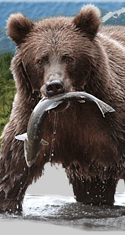 |
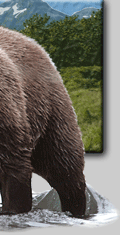 |
||||||||
 |
 |
 |
 |
|||||||
Photos by Mike Munsey and Robin Barefield
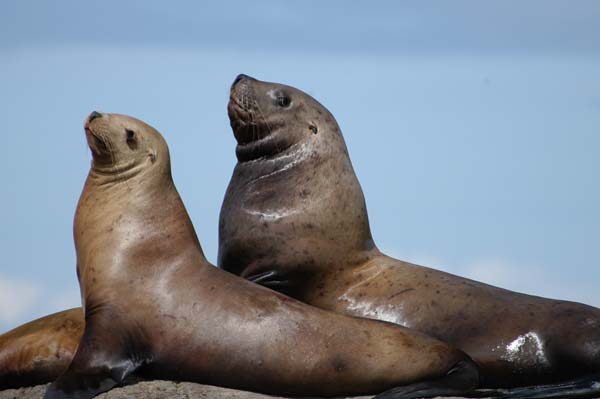 |
|
The Steller or Northern sea lion (Eumetopias jubatus) is a member of the order Pinnipedia, which includes harbor seals and walruses, and it is the largest species in the family Otariidae, the “eared seals”. This family also includes the California sea lion and the Northern fur seal.[1] Otariids, unlike phocids (the “true seals”), have external ear flaps, an elongate neck, long fore flippers used for propulsion, and hind flippers that can rotate, allowing sea lions to use all four limbs for movement on land.[1] They are called sea “lions”, because adult males have thick necks with long fur on the neck, resembling a lion’s mane.[2] Steller sea lions were named after German physician Georg Steller, who was the naturalist on the 1741 Russian expedition led by Vitus Bering.[3] Steller sea lions are found from southern California, along the coastline of the Pacific rim to northern Japan, but most of the breeding rookeries are located from the Gulf of Alaska to the Aleutian Islands.[4] Steller sea lions have been divided into two distinct populations, based on studies that show genetic and physical differences between the groups, as well as restricted gene flow from one group to the other.[5] The eastern population includes all sea lions east of Cape Suckling, Alaska, and the western population includes sea lions from Cape Suckling westward.[5] In 1990, Steller sea lions were listed as “threatened” under the Endangered Species Act, but in 1997, the western population was reclassified as “endangered” when it was determined that the Steller sea lion population from Russia to the Bering Sea to the Gulf of Alaska had decreased by more than eighty percent.[6] The eastern distinct population segment retained its “threatened” listing until October 2013 when NOAA determined this population segment had recovered and could be removed from the list of threatened species. The number of animals in the eastern population segment increased from an estimated 18,040 individuals in 1979 to an estimated 70,174 sea lions in 2010.[7] The western population segment has not recovered and is still listed as “endangered”.[7] In 1956, there were an estimated 250,000 Stellers in Alaska, and by the mid 1970’s, the population was estimated at 282,000, but between 1976 and 1990, the western population decreased by an average of 5.4% per year,[8] and the most precipitous decline occurred in the Aleutian Island and Kodiak regions.[4] Population counts from 1956 to 1960 indicated that the western Alaska population of Steller sea lions consisted of 140,000 animals. This population had decreased to 110,000 by the late 1970’s. By the 1990’s, the population was estimated at 30,525 individuals, but between 2000 and 2004, the western population began to stabilize and even increase in some areas.[4] Currently, there are 46,000 Steller sea lions in the western population segment.[2] |
|
Steller sea lions exhibit marked sexual dimorphism. Males, on the average, are 1.3 times longer than females, but they weigh 2.5 times more than females.[4] Adult male Stellers average 1500 lbs. (750 kg) and are 9 ft. (2.7 m) in length.[1] A maximum-sized male can weigh as much as 2500 lbs. (1120 kg) and be 10 -11 ft. (3-3.4 m) in length.[8] Females average 600 lbs. (272.7 kg) and are 7 ft (2.1 m) in length,[1] but may weigh as much as 770 lbs. (350 kg).[8] A Steller sea lion has a hefty body and a blunt snout. A male has a distinctive forehead and a mane of long hair on the back of his neck, shoulders, and chest.[9] This mane not only protects him from cold air and water temperatures and from jagged rocks on his haul-outs and rookeries, but it also protects him when fighting with other males.[4] Pups are dark brown at birth, and since the tips of their hair are colorless, they appear frosty. Their hair lightens after their first molt.[10] Adults are blonde to reddish- brown with dark- chocolate-brown on their undersides and flippers.[6] Females are usually lighter in color than males,[9] and unlike many other species of pinnipeds, adult Steller sea lions appear light in color, even when they are wet.[8] A Steller’s fur is thick and coarse,[6] and they shed or “molt” their fur every year.[7] The molt takes approximately four weeks and occurs in the late summer or early fall.[6] |
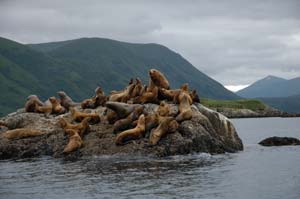 |
|
A sea lion has a streamlined body shaped like a torpedo, which reduces drag when moving through the water.[11] This streamlining is due to a thick layer of blubber under the skin. This blubber insulates the sea lion and provides an excess energy reserve.[12] Stellers have long, wing-like fore flippers that they stroke up and down to thrust themselves through the water in a movement that resembles flying.[3] They use their hind flippers for steering.[10] Unlike harbor seals, sea lions are able to fold their hind flippers under their bodies to walk on land. They are quite agile on land, and an adult male Steller can easily out-run a human.[3] Stellers, like all eared seals, have small, external ear horns.[3] Biologists believe that hearing is one of the most important senses for a sea lion, and they probably have acute hearing under water and fairly good hearing inair. Scientists suspect their above-water hearing is not quite as good as a human’s, but it is better than that of a harbor seal.[12] Sea lions have very good underwater vision. The lenses of their eyes are rounded, allowing them to focus on light that is refracted when it enters the water. Their retinas contain mostly rod cells, which are more effective in low light than are cone cells, and like harbor seals, sea lions have a tapetum lucidum, a layer of reflecting plates like a mirror, behind the retina. This mirror reflects light back through the retina a second time, allowing the sea lion to see in low light conditions.[12] Despite the small percentage of color-discriminating cone cells in the retina, recent studies on California sea lions indicate they are able to discern colors in the blue-green spectrum, probably aiding in their visual acuity under water.[12] Sea lions do not see as well above water as they do under water. They are able to detect outlines and rapid movement, but while their eyes are well-adapted to low light conditions under water, they have trouble seeing above water when it is dark.[12] Researchers believe that sea lions have a very poor sense of taste.[12] Since pinnipeds have small olfactory lobes, their sense of smell is probably limited, but a mother is able to recognize her pup by smell, and males can detect estrous females. It is also believed that a sea lion can smell a human from hundreds of meters away.[12] A sea lion uses its sensitive whiskers or “vibrissae” to explore objects under water and on land and to detect prey.[6] Tactile information is transmitted from the vibrissae to the brain via a nerve network.[12] |
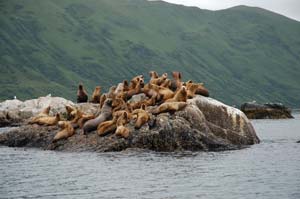 |
Steller sea lions are very vocal. At a haul-out, you may hear growls, roars, and grumbles from the older sea lions, along with lamb-like vocalizations from young pups.[10] Unlike California sea lions, Stellers do not bark. In southeastern Alaska, where Steller and California sea lions sometimes share haul-outs, it is easy to distinguish the California sea lions by the barking sound they make.[10] Steller sea lions use both haul-outs and rookeries. Rookeries are breeding colonies where sea lions mate, and females give birth; and haul-outs are areas where sea lions rest.[3] Rookeries are usually on sand, gravel, boulder, or bedrock beaches on fairly remote islands.[5] Rookeries are used during the mating and pupping season by adults and pups. Haul-outs are sites used by some non-breeding adults and sub-adults throughout the year and by adults during times other than the breeding season.[5] Haul-outs are especially important when Stellers molt for four weeks in the late summer or early fall.[6] A rookery site may be used as a haul-out once the breeding season is over, but haul-outs may also be on other rocks, beaches, reefs, floating docks, and sea ice. With the exception of ice floes,sea lions use the same rookeries and haul-outs from one year to the next.[5] It has been determined that Steller sea lions utilize more than 300 haul-outs and rookeries along the North Pacific rim, ranging from Hokkaido, Japan north to the Kuril Islands to Kamchatka and the Sea of Okhotsk, and east along the Aleutian Islands and into the Bering sea, through the Gulf of Alaska, and south through southeastern Alaska, all the way to the Channel Islands off California.[10] There are approximately 39 major rookeries and more than 250 haul-out sites in Alaska.[4] |
|
Female Steller sea lions reach sexual maturity between the ages of three and six, and most breed every year.[5] Males are sexually mature between the ages of three and seven, but they are not physically mature and large and strong enough to hold territories until they are nine to ten years old.[8] Male Stellers are very territorial, and holding and defending a territory is physically exhausting. Not only must they sometimes engage in fierce, often bloody, fighting with other bulls,[3] but a male often goes without eating for one to two months while he stays on the rookery to defend his territory.[8] Because of these exhaustive physical demands, males hold territories for an average of only two years, which means they only have a few mating seasons.[4] It is probable that most males never breed, but the largest, strongest, most successful bulls are those that hold territories, and they mate with many females, passing on their genes to the next generation.[3] Bulls come ashore at rookeries in mid-May,[4] and they use vocal and visual displays to establish territories, sometimes fighting with other males.[9] Bulls defending a territory will remain on the rookery until mid-July without eating or drinking.[4] Females arrive soon after the males and give birth to a single pup within three days of their arrival.[4] Females remain with their pups for five to thirteen days before leaving the rookery every one to three days to feed, and feeding trips generally last less than 24 hours.[4] Pups usually nurse for one year, but unlike other pinnipeds for which weaning is predictable, Steller pups may continue to nurse for up to three years.[5] Mothers use smell and vocalizations to create a bond with a newborn pup.[8] Approximately two weeks after giving birth, a female Steller will mate again.[8] Like many other animals, Steller sea lions exhibit delayed implantation. While a female breeds in June, the fertilized egg does not implant on the uterine wall until October, making the gestation period, from implantation until birth, approximately seven to eight months.[10] Pups are able to swim and crawl soon after they are born.[6] They are approximately 3.3 ft. (1 m) in length and weigh between 35 and 50 lbs. (16-22.5 kg).[8] Young pups are able to fast while their mothers leave on foraging trips,[10] and they do not grow much during the summer breeding season but begin putting on weight more rapidly from autumn to spring.[4] By their first spring, pups are able to dive nearly as deep as adults, but they don’t dive that deep very often.[10] As they grow, their swimming, diving, and foraging behavior begins to resemble that of adult Stellers.[10] |
|
Adult and older juvenile Steller sea lions can dive to at least 1500 ft. (500 m) and stay under water for 16 minutes.[10] They may take foraging trips over 62 miles (100 km),[4] and the longest foraging trip ever recorded was 550 miles (900 km) in the Bering Sea.[10] Normally, though, they dive for only three to five minutes and stay within 27 miles (45 km) of shore.[4] Their foraging behavior tracks the behavior of their prey. When prey are deeper during daylight hours, sea lions dive deeper to feed, and at night, when prey are closer to the surface, sea lions feed shallow. Large numbers of sea lions gather at places with seasonal runs of prey fish, such as salmon and herring,[10] and as commercial fishermen can attest, salmon caught in a gill net provide an easy meal for a sea lion. Studies where satellite tags have been attached to Steller sea lions indicate that adult females in the winter spend the most time diving and dive the deepest. Pups, on the other hand, spend very little time diving and dive only to shallow depths.[5] When at sea, Steller sea lions often form groups consisting of females, pups, and sub-adult males. Adult males usually don’t join these groups and are found alone.[9] A sea lion’s teeth are adapted for tearing. They don’t chew their food but swallow it whole or tear it into pieces before eating it.[11] There has been a great deal of research devoted to better understanding the diet of sea lions. During the mid-1970’s and 1980’s, data from stomach-content analyses on sea lions in the Gulf of Alaska indicated that walleye Pollock was their primary food source. Octopus, squid, herring, Pacific cod, flat fishes, capelin, and sand lance were also important to their diet. A study of sea-lion scat in the 1990’s confirmed that walleye Pollock was their primary food source, with Pacific cod and salmon also important at certain times of the year.[5] Scientists estimate that Steller sea lions must eat an average of five to eight percent of their body weight each day.[5] |
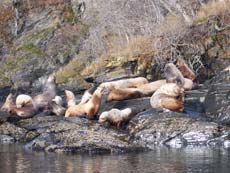 |
|
Steller sea lion females live up to thirty years, while males have a maximum life span of twenty years.[10] Males have a much higher mortality rate than females, probably at least in part due to the stresses incurred by securing and maintaining territories. By the time they are ten years old, there is a three to one ratio of females to males.[4] Stellers die from a number of causes; many are well-understood, but the underlying reasons for their dramatic population decline are still a mystery. A high number of aborted Steller sea lion fetuses are found in the wild,[6] and it is estimated that less than one-third of all pups reach sexual maturity.[3] Pups may be washed off the rookery by storm waves or killed by adults tossing, biting, or crushing them. A pup may also be abandoned by his mother or die from disease or starvation.[6] Threats to Steller sea lions of all ages include disease, loss of habitat, contaminants and pollutants, boat strikes, shooting by humans, entanglement in fishing nets and ocean debris, and indirect impacts, such as competition with fisheries for important food sources, including walleye Pollock.[2] It is known that sea lions are preyed upon by killer whales and sharks, but a recent study by a biologist at Oregon State University and a biologist with the Alaska Sea Life Center pinpointed a surprising possible predator of sea lions. Pacific sleeper sharks are a large, slow-moving species of shark that until recently were believed to be scavengers or to prey on fish. Pacific sleepers can grow to twenty feet (6.1 m) long, and there is now evidence that they may prey upon sea lions, although the incidence of this predation is unknown.[13] Biologists inserted “life-history transmitters” into the abdomens of thirty-six juvenile Steller sea lions. These transmitters record temperature, light, and other properties during thesea lions’ lives. When a sea lion dies, the tags either float to the surface or fall out on shore and transmit the data by satellite to researchers. Seventeen of the original thirty-six tagged sea lions have died. Fifteen of the transmitters indicated the sea lions had been killed by predation. Usually when a sea lion is killed, the tag is ripped out of the body and floats to the surface, recording a rapid temperature change and exposure to light. Three of the predation deaths were different, though. They recorded an abrupt drop in temperature, but they did not float to the surface and sense light, indicating that they were still surrounded by tissue. The obvious explanation is that they were eaten by a cold-blooded animal such as a shark. The only other possible shark candidates in the area are great white sharks and salmon sharks, both of which have counter-current heat exchangers in their bodies, giving them higher body temperatures than those recorded. Biologists believe the only possible predator in the area that is large enough to eat a sea lion and has a body temperature as low as those recorded is a Pacific sleeper shark.[13] While still much more research is needed to definitively identify Pacific sleeper sharks as predators of sea lions and to understand how many sea lions sleeper sharks actually kill and eat, the possible ramifications are troubling. Ground fish harvests in some area of the Gulf of Alaska have been limited in recent years to reduce competition for fish that are preferred by Steller sea lions. It is possible, though, that limiting fishing has led to more fish, providing a food base for a larger population of Pacific sleeper sharks, and adult sleeper sharks may in turn prey on sea lions. If this is true, then management directives may have harmed rather than helped the Steller sea lion population in the Gulf of Alaska.[13] |
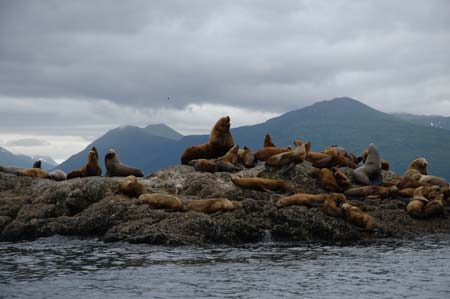 |
The relationship between Pacific sleeper sharks, sea lions, and ground fish is still not well understood, and it is a good example of the complexities of the North Pacific food web. Understanding why Steller sea lion populations, as well as populations of other pinnipeds, are decreasing in certain areas is not an easy undertaking. Several factors have been suggested to explain the decline of the western Steller sea lion population in the last three to four decades. Possible reasons are described as “top down” processes and “bottom up” processes. Top down processes include predation by killer whales or sharks; killing by humans, either directly such as by shooting, or indirectly by entanglement in fishing gear or ocean debris; and harassment of sea lions, especially at rookeries. Bottom-up processes include reduced prey quality and abundance, either due to competition with commercial fisheries or for some other reason; long-term shifts in their environment, such as changes in ocean temperature or an increase in contamination; and disease. At the present time, no one or combination of these factors sufficiently explains the decline of the western population of Steller sea lions.[5,10] There are currently a number of scientific studies examining the nutritional and biological needs of Stellers. An interesting result from a study by Carla Gerlinsky at the University of Washington showed that under-nourished sea lions are able to dive for a slightly longer period of time than unstressed sea lions when foraging for food. However, while the nutritionally-stressed sea lions are able to dive and therefore forage longer, they need more time on the surface to recover between dives, leading to longer foraging trips requiring more energy. These longer foraging trips also increase the risk of predation at sea and reduce the amount of time a female can spend feeding and taking care of her pup.[14] Other researchers are studying how sea lions fast for long periods of time and what biochemical adjustments their bodies make to supply sufficient energy.[15] Dr. Kate Wynne, a Kodiak marine mammal expert who works with the Alaska Sea Grant Marine Advisory Program, has been studying sea-lion scat that she and her colleagues scrape from rocks. She compares the sea-lion scat with harbor-seal scat, whose population was also in rapid decline in the Kodiak region but is now increasing four to nine percent per year in the area. She is trying to determine if there is some difference between the diets of seals and sea lions that could help explain why sea lion populations are still declining while harbor seal populations are on the increase.[16] Biologists and fisheries managers are also working on practical solutions to decrease human/sea lion conflicts, such as non-lethal ways to deter sea lions from raiding commercial fishing nets, signage near harbors and fish-cleaning stations to remind people that feeding sea lions is a federal offense, and methods of keeping fish-cleaning stations tidy, so sea lions can’t help themselves to fish scraps.[16] In Kodiak, sea lions were hauling out on an old breakwater float in the boat harbor, causing continual conflicts with humans at the harbor. When the old float was replaced with a new one, the old float was moved away from the dock, and the sea lions that had already staked claim to the float, moved with it, leaving the new float sea-lion free for human use.[16] |
|
References Cited 1. Wynne, Kate. 2007. Guide to Marine Mammals of Alaska. Alaska Sea Grant College Program, University of Alaska Fairbanks. ISBN 1-56612-121-3. 2. Steller Sea Lion. The Marine Mammal Center. Available at: www.marinemammalcenter.org 3. Horning, Markus. Biology and Ecology of the Steller Sea Lion. Available at: sealtag.org/images/Reading_Bio_and_Ecology.pdf. 4. Steller Sea Lion Biology. North Pacific Marine Mammal Research Consortium. Available at: marinemammal.org. 5. Mundy, Phillip R. 2005. The Gulf of Alaska Biology and Oceanography. Alaska Sea Grant College Program, University of Alaska Fairbanks. 6. Steller Sea Lions Biology Facts. Available at: www.marinemammal.org/biology/steller-sea-lion/ 7. NOAA Removes The Eastern Steller Sea Lion From The Endangered Species Act List. Available at: alaskafisheries.noaa.gov/newsreleases/2013/easternssl102313.htm. 8. Steller Sea Lion (Eumetopias jubatus). Office of Protected Resources – NOAA Fisheries. Available at: www.nmfs.noaa.gov/pr/species/mammals/pinnipeds/stellersealion.htm. 9. Cresswell, Graeme, Dylan Walker, and Todd Pusser. 2007. Whales and Dolphins of the North American Pacific including Seals and other Marine Mammals. Harbor Publishing. ISBN: 978-1-55017-409-0. 10. Steller Sea Lion (Eumetopias jubatus). Species Profile. Alaska Department of Fish and Game. Available at: www.adfg.alaska.gov/index.cfm?adfg=stellersealion.main. 11. What are Sea Lions? Available at: www.atlantis.com/content/...sealionbrochure.pdf. 12. California Sea Lion. Available at: seaworld.org/en/animal-info/animal-infobooks/California-sea-lion. 13. Study: Could sleeper sharks be preying on protected Steller sea lions? Oregon State University. 2014. News & Research Communications. Available at: oregonstate.edu/ua/ncs/archives/2014/oct/study-could-sleeper-sharks-be-preying-protected-steller-sea-lions. 14. Running on Empty. Does nutritional status influence diving behavior in Steller Sea Lions? 8/18/2014. North Pacific Universities Marine Mammal Research Consortium. Available at: http://www.marinemammal.org/2014/08/running-on-empty/ 15. Seasonal Differences in Biochemical Adaptation to Fasting in Juvenile and Subadult Steller Sea Lions. 8/20/2009. North Pacific Universities Marine Mammal Research Consortium. Available at: http://www.marinemammal.org/2009/08/seasonal-differences-in-biochemical-adaptation-fasting-in-juvenile-and-subadult-steller-sea-lions/ 16. Koppes, Mary. 09/18/2014. What’s behind the Steller sea lion decline? Pinniped expert presents research. Wrangell Sentinel. Available at: www.wrangellsentinel.com/story/2014/09/18/news/whats-behind-the-steller-sea-lion-decline-pinniped-expert-presents-research/2489.html.
|
Copyright 2012 Munsey's Bear Camp